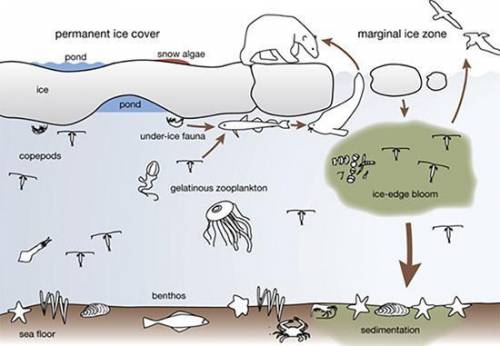
Biology, 22.10.2020 17:01 yurlgurllmay
Despite the extremely cold conditions that lead to the formation of the ice, a huge diversity of life depends on the ice to exist. Microbes, including algae that live in dense mats on the underside of the ice, make up the bulk of the biomass within the ice, and act as the base of the sea ice food web. Parasitic fungi can infect ice algae and may limit their growth. Bacteria within the ice serve to degrade dead organisms and recycle their nutrients for use by the ice algae.
Zooplankton, including crustaceans like copepods, eat the ice algae and are then eaten by larger animals. Polar bears, seals, walruses, whales, birds, and other animals make use of the ice for feeding, breeding, and protection.
Ice algae can also be important contributors to the benthic food web because they tend to sink rapidly to the bottom in the summer when the ice melts and they are released into the water column.
The Sea Ice Food Web begins with gelatinous zooplankton, which include copepods, different ice edge bloom, and under ice fauna. The next trophic level includes fish. The next level is seals. The next level is polar bears. The sea floor includes sedimentation at the benthic food web.
© NOAA - Office of Ocean Exploration and Research
Use the food web to identify the following:
Identify the trophic level represented by gelatinous zooplankton under the sea ice.
Identify the secondary and tertiary predators in the sea ice food web.
Describe the effects of removing seals from the sea ice food web.
Energy transfers between trophic levels:
Fish produce 1,000 grams of biomass, which represents usable chemical energy. Describe the approximate amount of energy from that biomass that will transfer from fish to polar bears.
Explain why energy is lost moving from a lower trophic level to a higher trophic level.


Answers: 2


Other questions on the subject: Biology

Biology, 22.06.2019 10:00, christinavelez26
In the presence of oxygen, glycolysis is followed a. the krebs cycle b. lactic acid fermentation c. alcoholic fermentation d. photosynthesis
Answers: 2

Biology, 22.06.2019 14:00, briannamaee13
Which material is commonly used as a culture medium for living cells
Answers: 2

You know the right answer?
Despite the extremely cold conditions that lead to the formation of the ice, a huge diversity of lif...
Questions in other subjects:


Geography, 27.01.2020 11:31



Biology, 27.01.2020 11:31


Mathematics, 27.01.2020 11:31

Mathematics, 27.01.2020 11:31


Spanish, 27.01.2020 11:31



